The current methods for on-farm euthanasia of late finishing age (4-6 months of age) or adult swine rely on individual animal handling and restraint.1,2 Individual animal handling is problematic for large-scale depopulation due to the physical and emotional stress on personnel, leading to increased hazardous situations.3 As in a foreign animal disease outbreak, an efficient euthanasia method that accounts for animal and human welfare is needed in a depopulation event. The American Veterinary Medical Association (AVMA) defines depopulation as the “rapid destruction of a population of animals in response to urgent circumstances with as much consideration given to the welfare of the animals as practicable.”4
Carbon dioxide (CO2) inhalation is an AVMA approved euthanasia method for individual swine but requires special equipment.5 For appropriate use of CO2 in a depopulation event for multiple animals at once, a mobile method for application to adult swine is needed. An advantage CO2 inhalation has over other inhalant gases is its nonflammable properties and easy reversal if accidental human exposure occurs.6,7 Previous studies on the modeling of dump trucks for the CO2 depopulation of pigs show that it can be operational if design specifications are met.3,8 Required specifications include an airtight seal at the bottom and sides, an impermeable top cover, a vent to allow displaced oxygen to escape, and CO2 to be introduced at a 20% volume/minute rate.1,3,6 The further advantage of the dump trailer is for pigs to be depopulated outside of the barn and carcasses to be efficiently transported to a designated location for disposal. This depopulation of pigs outside the barn prevents the need to physically remove each carcass from the building, thus increasing worker safety, caretaker well-being, and depopulation process efficiency.1
The development of specifications and modifications to a standard dump trailer that the swine industry can replicate would provide an easily constructed and readily accessible option when depopulation events arise. This project provides the modifications made to a standard 2.4 m wide × 12 m long × 1.02 m tall vertical hydraulic dump trailer to produce a mobile CO2 depopulation apparatus. This project also confirms the success of the CO2 trailer on finisher pigs and adult swine.
Animal care and use
Animals were used under the guidelines and approval of the Pipestone Research Institutional Animal Care and Use Committee protocol ID No. 2020-009.
Materials and methods
Animals
A total of 160 pigs (mean weight = 82 kg) and 42 sows (mean weight = 198 kg) were used in this study. Finishing age pigs were divided into two trailer-load groups (80 pigs each). Eight finisher pigs were sedated for surgical implant installation with a cocktail of tiletamine, butorphanol, and xylazine. The subcutaneous implant monitors (DST centri-HRT ACT; Star-Oddi) measured the animal’s heart rate (beats per minute [bpm] derived from electrocardiogram [ECG]), activity (external acceleration > 1 standard gravity), and body temperature. The external acceleration from the activity was measured by a calculation on the external acceleration of the g-force above the standard gravity from a 3-axis accelerometer. Implants were installed over the xiphoid process of the sternum. Animals were implanted 48 hours before CO2 administration to attain baseline information after the sedatives were cleared from the body. Implant readings were taken every 30 minutes until the day of CO2 administration when readings were then taken every 15 seconds. The implanted finishing age pigs were assigned by convenience into two different loads for CO2 exposure. Immediately after the CO2 administration, the pigs were visually inspected for any signs of breathing or movement. If breathing or movement was observed, CO2 administration would be repeated for an additional complete cycle. Pigs were also visually inspected for any signs of movement or breathing while carcasses were emptied onto the ground. If breathing or movement was observed at this stage, the captive bolt euthanasia method was applied immediately. Following captive bolt administration, the animal was confirmed dead by lack of corneal reflex when touching the eye and the cessation of breathing under the observation of a licensed veterinarian.
Trailer
A 2.4 m wide × 12 m long × 1.02 m tall standard frameless, open-top, hydraulic lift, double-axle dump trailer was modified to handle CO2 gas input. A vertical sliding door was installed on the rear of the trailer to be flush with the barn’s chute and be able to open or close as needed for loading pigs (Figure 1). A ceiling was built inside the trailer at the height of 1 m to limit the area needed to be filled with CO2 and ensure animals could not lift their heads above the CO2 gas. The ceiling was made from aluminum material and was hinged with liftable panels down the center to provide an alleyway for people to walk upright with a sorting board to aid in loading the trailer (Figure 2). The aluminum ceiling was welded into place with an overlapping lip on one side of the liftable panels to prevent a gap formation (Figure 2). Duct tape (Gorilla Tape; Gorilla Glue, Inc) was placed over the trailer liftable ceiling panel seams to ensure an airtight seal before CO2 inflow began.
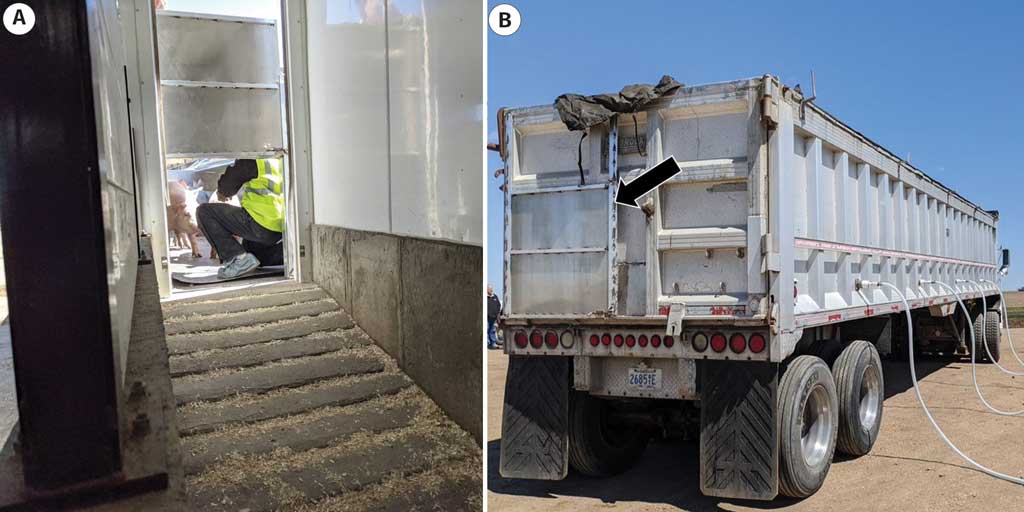
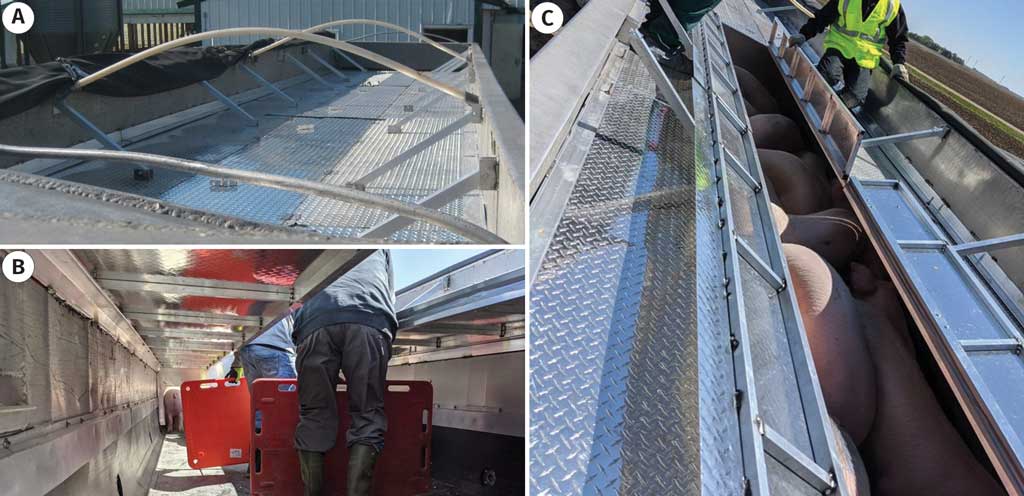
A swing gate hinged near the top of the installed ceiling that could be lowered and locked was installed at the halfway point of the trailer length (Figure 3). This gate could be locked after the front half of the trailer was loaded with animals so they could not run back off the trailer while the back half was filled. Animals were loaded onto the trailer using a sorting board with the same methods used and level of difficulty experienced when loading pigs onto a livestock trailer for transport. After the trailer was fully loaded, the hinged swing gate was unlocked, and the CO2 filling began. The gate could swing open during the dumping process.
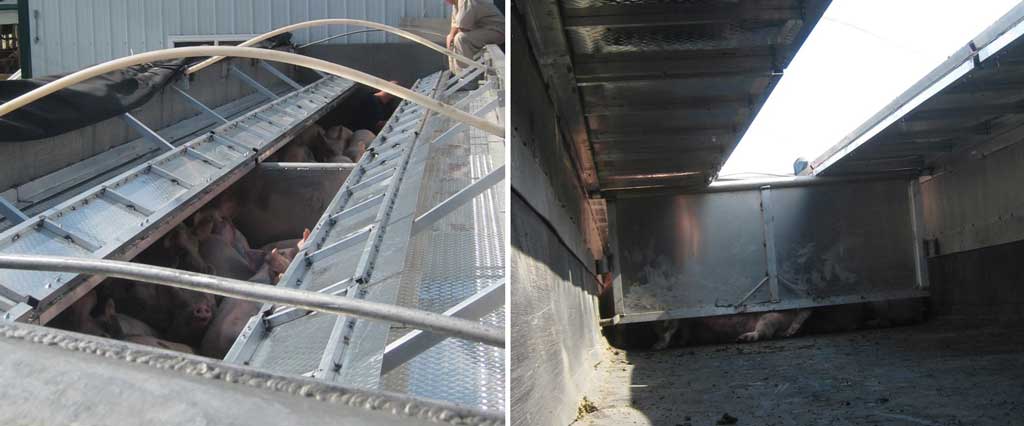
Four 1.25-inch ball valve ports were installed into the lower sidewall on one side of the trailer. On the opposite side, four ball valve ports were installed high on the trailer but below the ceiling (Figure 4). The lower ports allowed for CO2 input, while the higher ports allowed oxygenated air to escape as CO2 gas filled from the bottom. Plastic piping was added onto the end of the oxygen escape ports to ensure any escaped CO2 would flow towards the ground and not into an area where people may walk (Figure 4).
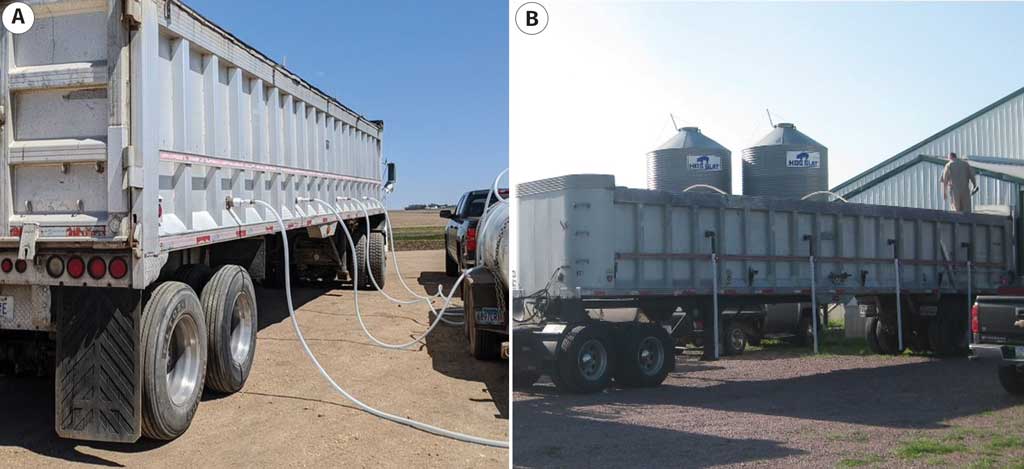
CO2 administration
The transfer of CO2 from high-pressure to low-pressure tanks for flowing into the trailer was based on previously published work.1 During this project, the ambient outside temperature was 23°C. The 1000-gallon low-pressure repurposed tanks (former propane tanks) were filled from a high-pressure CO2 vertical gas-liquid (VGL) cylinder through a non-electric ambient air approximately 2500 standard cubic feet per hour vaporizer (Thermax; Chart Industries). The repurposed low-pressure tanks were refurbished with new fittings, gauges, and pressure relief valves for safety. The VGL cylinder and vaporizer were transported in a separate enclosed trailer and two 1000-gallon tanks on an open trailer (Figure 5). The CO2 flowed into the trailer through the four CO2 ports by hoses connected to a 1000-gallon low-pressure tank (4 hoses/tank). Each 1000-gallon tank was filled with enough CO2 to fill the dump trailer up to the installed ceiling (120 psi). A regulated valve allows a flow of 20 to 24 psi/minute for 5 minutes for the tank feeding into the trailer. After the 5-minute fill time, all valves (oxygen and CO2) were closed, and the trailer was held sealed for 10 minutes (15 minutes total time from CO2 start to end of holding time). After holding time, ceiling panels were opened, and animals were inspected for any signs of breathing or movement. If no breathing or movement signs were observed, the carcasses were removed from the trailer by gravity via the trailer’s hydraulic lift system (Figure 6). Carcasses were examined for any signs of breathing or movement during and immediately after the truck emptying process, moving carcasses around as necessary for proper visualization of all animals.
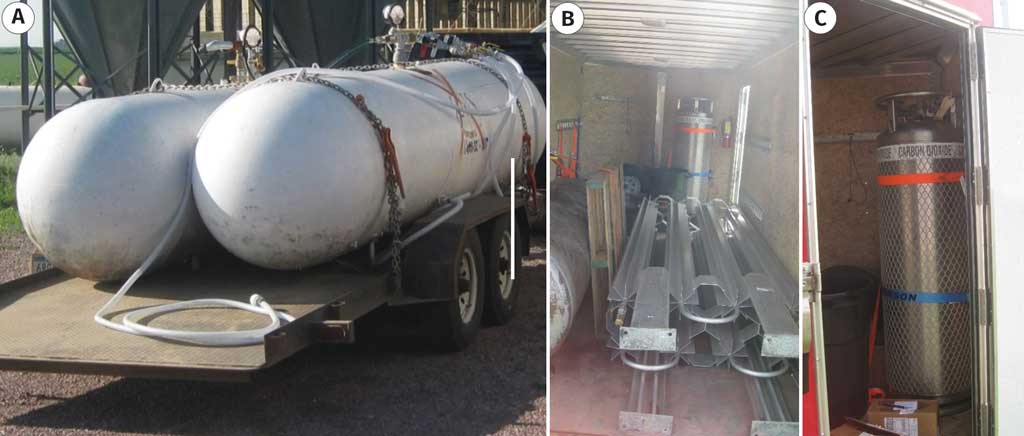
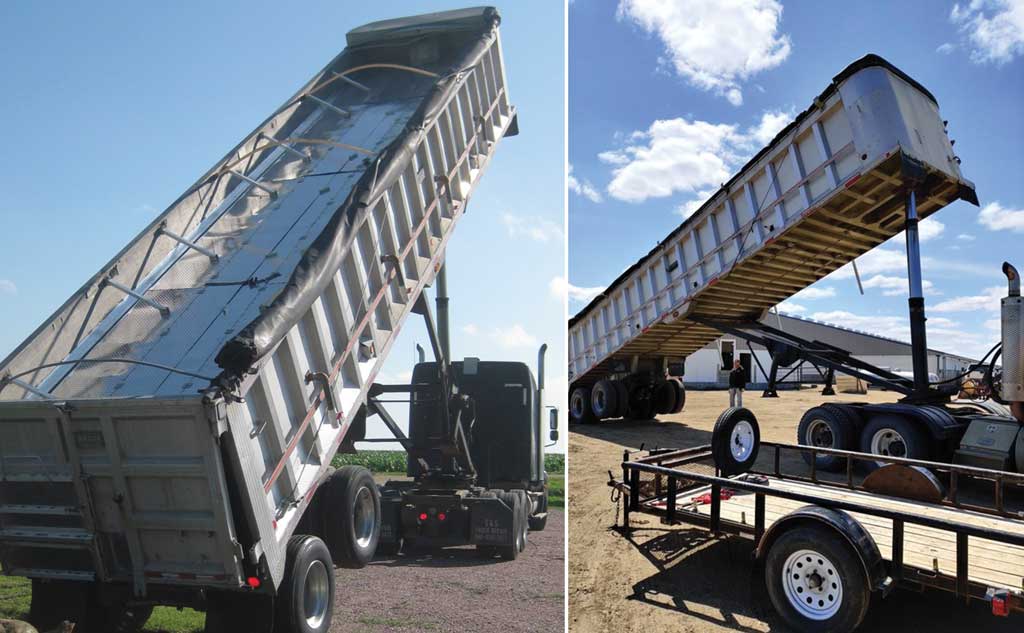
Results
Implant results
One pig did not recover from sedation for implant placement, allowing for readings from only 7 of the 8 pigs. A substitute pig was added to keep the finisher pig numbers the same but did not have an implant placed. The ECG images from the individually implanted pigs showed no regular sinus rhythms at the end of the holding time. Figure 7 demonstrates the decrease in heart rate and activity readings throughout the CO2 exposure and holding process. Figure 7 also shows heart rate and activity measurements at 22 minutes before starting the CO2 inflow into the trailer, which would encompass the time to load the pigs onto the trailer. Body temperature readings from the implanted pigs ranged from 39.5°C to 40.7°C with a mean body temperature of 40.1°C from the time the CO2 inflow was started to the end of the holding time. All implanted pigs experienced an increase in body temperature over the CO2 inflow and holding time.
Animals
Of the 160 finisher pigs (2 trailer loads of 80 pigs each) in this study, one pig in group 1 was observed to begin breathing after the trailer was emptied. This pig did not show any signs of positional self-righting behavior or respond to being physically touched. This animal was euthanized immediately by a captive bolt device. The cessation of life for all 42 sows (1 trailer load) was successful after the CO2 holding time was completed.
Discussion
The filling of CO2 and the displacement of oxygen are necessary for the trailer unit to work. The heavier molecular weight of CO2 allows the displacement of the oxygenated air out of the higher release valves on the trailer.7 The ability to close the oxygen release valves also helped minimize CO2 loss through them once the trailer filled based on the flow rate. The one pig from group 1 that began breathing again after the hold time was completed demonstrated the importance of a near airtight container. That pig was located next to the vertical sliding door which did not seal completely and allowed oxygenated air to leak in. The vertical door was ensured to be slid down completely into place and flush with the truck’s frame for all remaining groups. Depending on how other sliding doors in the field are constructed, sealing the outside door seam with duct tape may be helpful. The sows used in this project were tall enough to push on the trailer’s ceiling when they raised their heads. The weight of the ceiling and duct tape covering the panel seams were sufficient to still attain proper CO2 exposure without leaking in oxygen. If the trailer is used frequently on adult animals, a higher ceiling may be beneficial to better accommodate their size. Further use of the unit in the field outside of the current study has been 100% successful on approximately 700 finisher swine and 3000 nursery pigs (20-30 days of age).
The implant monitor results for activity and heart rate were limited to 7 finisher animals in this project and not completed in the sows. As seen in Figure 7, recorded activity levels flattened out, and recorded heart rates reached 0 bpm in the implanted pigs. At the end of the holding time, images of the implant ECG readings revealed an absence of normal sinus rhythm in the individual pigs. The lack of sinus rhythm in brain death is supported in the human literature by the documented progressive loss or depression of sinus activity in the terminal stages of brain death.9 As expected, Figure 7 shows the heart electrical activity, measured as bpm, continuing after death occurs due to the heart’s sinoatrial node activity even after brain death may have occured.9,10
A spike in activity in the second group can be attributed to the dump trailer’s movement to the designated unloading location at that time. In the first group, the dump trailer was left stationary before moving to the selected unloading location. The accelerometer measurements of pig activity allow for an objective way to monitor the general animal activity without subjective human observation. This objective ability to monitor was helpful in this study where the physical observations could not be performed during the CO2 exposure process. Group 1 showed greater spikes in activity readings than group 2, but the activity readings flattened out in both groups before the end of the holding time. Spikes in activity levels were visually comparable for both groups before the start of CO2, with activity readings flattening out just prior to the end of the holding time and did not resume afterward. This reduction of activity provides confidence that the CO2 inhalation was influencing the pigs. Heart rate in both groups remained above 100 bpm until after the CO2 exposure cycle was complete, staying comparable to the period of readings taken before CO2 inflow was started. The spikes in activity and visually typical heart rates between CO2 fill and end of holding time compared to the pre-exposure suggest the pigs may have been able to recover if exposed to oxygenated air during this time (Figure 7). This observation supports the importance of maintaining the recommended 15 minutes for CO2 exposure (5 minutes of CO2 fill with a 10-minute hold).1,3,6 The ability for animals to recover if not adequately exposed to the complete CO2 cycle is supported by the 1 pig in the current study that was able to resume breathing when oxygenated air was allowed to leak through the improperly closed sliding door.
Body temperatures did show a slight rise throughout the CO2 inflow and holding procedure. This increase in temperature is possibly due to the ambient temperature inside the trailer. The trailer internal ambient temperature could rise due to the lack of air movement coupled with animal movement until sedation from the CO2 inhalation and pig respiration until death. The shortcomings of this study include the lack of a CO2 monitor inside the trailer to confirm gas concentration. Another shortcoming is the lack of ambient temperature measurement from inside the trailer during the CO2 fill and holding time.
The transfer of CO2 from the high-pressure VGL to the low-pressure tanks is the greatest time-limiting step of the process. The non-electric vaporizer (heat exchanging device) greatly hastened this gas transfer rate, saving time. The vaporizer helps fill the low-pressure tanks with CO2 from VGL cylinders in approximately 30 minutes at 23°C ambient environmental temperature. Without the vaporizer, the flow is kept slow to decrease the loss of CO2 to dry ice formation.1,7 The vaporizer utilized in the current study would require supplemental heat in colder temperatures to provide the same flow rate into the low-pressure tanks. In case supplemental heat was needed, the vaporizer was hauled on an enclosed trailer that could be heated if necessary. Other vaporizer models may allow for CO2 transfer under more extreme temperature conditions outside the ambient temperatures explored in this study.
The trailer modifications for use as a portable CO2 unit provided a success rate of 99.5% (201 of 202 pigs) of finisher pigs and sows depopulated. This unit provides a viable tool for the industry for application in a foreign animal disease outbreak where a depopulation event is required. Greater efficiencies in the process may be found with further research into other in-field options.
Implications
Under the conditions of this study:
- A standard dump trailer can be modified into a mobile CO2 depopulation unit.
- Minimizing potential air leaks is essential for CO2 depopulation success.
Acknowledgments
The authors would like to acknowledge the National Pork Board for funding this project. The authors would also like to thank all the other Pipestone employees and maintenance staff who helped complete this project.
Conflict of interest
None reported.
Disclaimer
Scientific manuscripts published in the Journal of Swine Health and Production are peer reviewed. However, information on medications, feed, and management techniques may be specific to the research or commercial situation presented in the manuscript. It is the responsibility of the reader to use information responsibly and in accordance with the rules and regulations governing research or the practice of veterinary medicine in their country or region.
References
1. Rice M, Baird C, Stikeleather L, Morrow M, Meyer R. Carbon dioxide system for on-farm euthanasia of pigs in small groups. J Swine Health Prod. 2014;22(5):248-254.
2. Meyer RE, Morrow WEM, Stikeleather LF, Baird CL, Rice JM, Byrne H, Halbert BV, Styles DK. Evaluation of carbon dioxide administration for on-site mass depopulation of swine in response to animal health emergencies. J Am Vet Med Assoc. 2014;244(8):924-933.
3. Stikeleather L, Morrow W, Meyer R, Baird C, Halbert B. Evaluation of CO2 application requirements for on-farm mass depopulation of swine in a disease emergency. Agriculture. 2013;3:599-612. doi:10.3390/agriculture3040599
*4. American Veterinary Medical Association. Guidelines for the Depopulation of Animals: 2019 Edition. Schaumburg, Illinois: American Veterinary Medical Association; 2019. Accessed 14 October 2020. https://www.avma.org/sites/default/files/resources/AVMA-Guidelines-for-the-Depopulation-of-Animals.pdf
*5. American Veterinary Medical Association. Guidelines for the Euthanasia of Animals: 2020 Edition. Schaumburg, Illinois: American Veterinary Medical Association; 2020. Accessed 14 October 2020. https://www.avma.org/sites/default/files/2020-02/Guidelines-on-Euthanasia-2020.pdf
6. Meyer R, Whitley JT, Morrow WEM, Stikeleather LF, Baird CL, Rice JM, Halbert BV, Styles DK, Whisnant CS. Effects of physical and inhaled euthanasia methods on hormonal measures of stress in pigs. J Swine Health Prod. 2013;21(5):261-269.
7. Meyer R, Morrow WEM. Carbon dioxide for emergency on-farm euthanasia of swine. J Swine Health Prod. 2005;13(4):210-217.
8. Kinsey JC, Foster JA, Reitz RL. Development of a self-contained carbon dioxide euthanasia trailer for large-scale euthanasia of feral swine. Wildl Soc Bull. 2016;40:316-320. doi:10.1002/wsb.664
9. Drory Y, Ouaknine G, Kosary IZ, Kellermann JJ. Electrocardiographic findings in brain death; description and presumed mechanism. Chest. 1975;67(4):425-432. doi:10.1378/chest.67.4.425
10. Kashou AH, Basit H, Chhabra L. Physiology, Sinoatrial Node. StatPearls Publishing. January 2020. https://www.ncbi.nlm.nih.gov/books/NBK459238/
* Non-refereed references.
